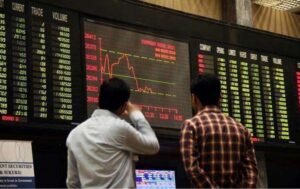Pakistan is late to the party. E-commerce is booming throughout our immediate region. India’s leading e-commerce website, Flipkart, recently raised a record $1 Billion in new investment, handling 5 Million shipments each month. The website sees so much potential in mobile shopping that it has a stated goal of becoming “the mobile e-commerce company of the future”.
To our north, China’s e-commerce leader, Alibaba, set a global record when it listed its shares on the New York Stock Exchange in September. Alibaba’s Initial Public Offering raised a staggering $25 Billion, making its record-breaking IPO the biggest in the world. Today the Chinese e-commerce giant’s market capitalization is over $250 Billion exceeding that of Wal-Mart, the world’s largest old economy retailer. The market value of e-commerce companies in Pakistan’s immediate vicinity including Turkey, the Middle East, India and China exceeds half of a trillion dollars.
But the party has indeed finally started in Pakistan as well. By 2017, the size of our e-commerce market is expected to reach over $600 Million from it’s current size of $30 Million spent on online purchases annually. There are several factors driving this growth, which will dramatically change the way we buy things over the next several years.
Growth of Internet Penetration
Pakistan’s Internet penetration rate historically exceeded that of India until 2009. In 2009, India launched 3G and its Internet penetration sky-rocketed. The same hockey stick growth took place in Sri Lanka’s after its 3G launch in 2006. With Pakistan’s long awaited entry into the 3G club a few months ago, there will be a similar burst of Internet accessibility which will further catapult online purchases.
Following the pattern of our neighbors, Pakistan’s Internet enabled population will increase from 30 Million users today to 56 Million in 2019. Over the next five years, 28% of the country’s citizens will have Internet access. This unprecedented reach will transform not just how consumers purchase goods, but will also significantly impact several other industries. My own online jobs classifieds site, ROZEE.PK, today processes 40,000 job applications a day and has helped over 1 Million people find jobs. Social media sites including Facebook and Twitter are transforming how we consume news and shape opinions.
Ubiquity of Access through Mobile
Along with the rise of Internet accessibility through 3G, Pakistan is simultaneously witnessing a surge in smartphone usage. There are an estimated 9 Million smartphone users in Pakistan, using handsets that are fully equipped with web browsers and online connectivity. Smartphones have become increasingly sophisticated, not only substituting many functions previously only capable through desktop and laptop computers, but also greatly increasing the ease of going online. Not only is the Internet becoming more accessible to consumers, consumers are also becoming more accessible to Internet merchants through the ubiquity of the smartphones in our pockets.
While the growth of smartphones in Pakistan is linked to the rise of Internet penetration, it is more so driven by the declining cost of increasingly sophisticated devices. Chinese companies which have traditionally manufactured devices for the world’s leading mobile phone brands including Apple and Samsung, are now OEM’ing their own handsets for a fraction of the cost powered by Google’s Android operating system. So significant is this trend that Samsung’s third quarter profits fell by 50% as its mobile business continued to lose ground to low-cost Chinese smartphone makers.
The sub Rs. 5,000 price point of relatively powerful smartphones in Pakistan is enabling online accessibility to penetrate a lower untapped income strata of society. My cook now downloads recipes from the Internet on his smartphone.
India’s Flipkart sees so much potential in mobile shopping that it has a stated goal of becoming “the mobile e-commerce company of the future”.
Online Payment Initiatives Are Mushrooming
While over 95% of online purchases are fulfilled through Cash on Delivery (COD) in Pakistan, several promising initiatives are underway which will make it easier to pay directly online. Many banks and telcos alike have launched branchless banking and m-commerce initiatives ranging from MCB Banks’s MCBLite, Telenor’s Easy Paisa, Mobilink’s Mobicash, Zong and Askari Bank’s Timepay, UBL’s Netbanking and others. The number of branchless banking agents which facilitate offline payments for online purchases tripled from 41,000 in 2012 to 125,000 in 2013, making it increasingly easier and more convenient to transfer money.
One of the most frequent complaints from Pakistan’s online sellers of not being able to get merchant accounts that allow them to card payments online, has been abated. While Citibank Pakistan was once the only bank in the country to offer online merchant accounts, it was also notoriously difficult for businesses to get approved. When the bank wrapped up its consumer banking operations in 2012, it left its approximately paltry 14 approved merchants high and dry without an online card processing facility. However, UBL has since launched its Go Green Internet Merchant Account product for businesses which is far more reasonable in its on-boarding criteria. Online merchants can now potentially collect payments electronically from 12 Million debit cards in Pakistan.
Perhaps the most successful online payment solution currently available in the country is Inter Bank Fund Transfer (IBFT). A large volume of payments are made by consumers directly going to their bank’s website to electronically transfer funds to online stores. Most banks are now offering their customers net banking IBFT payment facilities through their websites, bringing a majority of the country’s banked population into the fold of electronic payments.
Maturing Logistics and Parcel Delivery Infrastructure
Currently 95% of online purchases are paid for through COD at the time the parcel is delivered to customer. TCS, BlueEX, Leopards and other couriers are providing COD delivery services across over 150 cities in the country. This becomes especially relevant when considering that approximately 35% of the the country’s monthly 70,000 COD shipments are delivered to cities outside the three main urban centers of Karachi, Lahore and Islamabad. While urban shoppers are more online as a percentage of population, the value for rural shoppers is higher as many products are not available in their local markets. This implies a huge untapped segment of the population that will increasingly transition to online shopping.
Growing Trust in Online Storefronts
One of the main obstacles to the growth of e-commerce is the lack of consumer trust in purchasing from the “cloud”. As a dotcom entrepreneur in Silicon Valley during the 1990’s, I recall the prevailing conventional wisdom at the time: people would never give their credit card information on the Internet to buy items. Today, over 72% of Internet users in the US are digital shoppers. This contrasts sharply with less than 3% of Pakistani Internet users who have bought goods online. Although we have a long way to go, there is correspondingly huge upside potential as well.
After initial hesitation, an inflection point in consumer behavior was reached in the US during the late nineties with strong online storefront brands such as Amazon taking to mainstream media. The large amount of investment these sites were able to raise, coupled with highly professional teams, led to positive shopping experiences for the risk averse early adopters who ventured to buy online. We will see this same pattern in Pakistan.
For the first time in the country’s history, we are seeing online brands deploying significant advertising budgets for mainstream media advertising. Deep pocketed general classifieds sites like OLX, funded by the South African mega media group Naspers, and Asani, a Schibsted funded company from Norway, have embarked in our online industry’s first media war with ads competing for our eyeballs. Rocket Internet, which runs Daraz and Kaymu in Pakistan, recently completed an $8.2 Billion IPO in October of this year. Daraz and Kaymu are well funded and will be pouring capital into the Pakistani e-commerce market in a magnitude not seen here before. Several other Pakistani online players will be launching their TV ads in the coming months, giving new credibility to the online medium and e-commerce.
All of these developments will lead to a rapid increase in trust as first time online shoppers experience e-commerce and generate acceptance through word-of-mouth.
Big foreign investors are a swooping in to become first movers in key verticals in the world’s sixth most populous country with the goal of claiming online thrones. Visionary local players like Homeshopping, Shophive and Symbios are organically emerging from our ecosystem and bootstrapping to success. This is a winner-takes-all market: the largest marketplaces grow the fastest making it unviable for new entrants as the industry heats up. And this industry has a voracious appetite for capital. The e-commerce party has started.
_______________________________________________________________________________________________________

Analysis by Monis Rahman. Monis Rahman is Chairman and CEO of Naseeb Networks and is one of Pakistan’s most prolific Internet entrepreneurs. He runs leading online job classifieds sites ROZEE.PK in Pakistan and Mihnati.com in Saudi Arabia.

Fahad is an entrepreneur and a marketing enthusiast who loves to write on trending topics. He loves travelling & playing tennis is what he does in his leisure time. He tweets @fahad164.
Email:- fahad164@gmail.com , fahad@themediaparadigm.com











